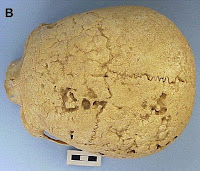Shell mounds are archaeological sites common in coastal areas around the world. In Brazil there are hundreds of such mounds, mostly dating to between 8000 and 1000 years ago, with the greatest abundance being found in Espírito Santo and Santa Catarina States. The Tarioba Shell Mound is located in Rio das Ostras Muncipality in eastern Rio de General State. It was discovered in 1967, but not excavated until 1998-1999, when the site was completely excavated, with the material being relocated to a museum, with the site subsequently being developed. The site had five layers, dated to between 3620 and 3440 years ago, though the site shows signs of overturning with the oldest layer at the top. A total of 47 Mollusc species have been described from the site, as which also yielded numerous Decapod Crustacean specimens, predominantly chelae (claws).
In a paper published in the journal Check List on 28 March 2016, Felipe Barta Rodrigues, Michelle Rezende Duarte and Rosa Cristina Corrêa Luz de Souza of the Laboratório de Genética Marinha e Evolução at the Universidade Federal Fluminense, Abílio Soares‑Gomes of the Laboratório de Ecologia de Sedimentos Marinhos, also at the Universidade Federal Fluminense and Edson Pereira Silva, again of the Laboratório de Genética Marinha e Evolução at the Universidade Federal Fluminense, analyze and describe the Crustacean material from the Tarioba Shell Mound.
Rodrigues et al. describe nine species of Decapod from five layers, these being Callinectes danae, a type of Swimming Crab, Callinectes sapidus, the Atlantic Blue Crab (another type of Swimming Crab and a species still widely eaten and considered economically important in the United States), Cardisoma guanhumi, the Blue Land Crab, Goniopsis cruentata, the Mangrive Root Crab, Menippe nodifrons, the Cuban Stone Crab, Mithrax hispidus, the Shaggy Climbing Crab, Ocypode quadrata, the Atlantic Ghost Crab, Ucides cordatus, the Atlantic Mangrove Crab and Panopeus austrobesus, the South American Mud Crab.
Voucher specimens, with morphological characters used for identification. (A) Callinectes danae (elongated dactyl format. Teeth arranged in a single row, with two small followed by a larger one pattern. More pointed teeth than the Callinectes sapidus); (B) Callinectes sapidus (elongated dactyl format, teeth arranged in a single row, with two small followed by a larger one pattern); (C) Cardisoma guanhumi (rounded tubers, arranged in a row, the largest tuber near to the palm); (D) Goniopsis cruentata (curved dactyl format, with teeth distributed in four rows); (E) Menippe nodifrons (large tuber at the base, followed by other smaller tubers); (F) Mithrax hispidus (curved dactyl format, teeth arranged in a single row, with the largest tooth near to the palm); (G) Ocypode quadrata (small tubers arranged in four rows, it has small thorns arranged in a single row); (H) Ucides cordatus (tubers arranged in three rows with other dispersed, it has thorns records); (I) Panopeus austrobesus (curved dactyl format, with a large basal tooth). Scale bars are 5 mm. Rodrigues et al. (2016).
The most biodiverse layer was the uppermost (oldest), in which all the species were present, with the other layers each having eight species. The presence of more species in the oldest layer could be taken as indication of loss of biodiversity due to consumption over the time the site was occupiedm however Rodrigues et al. do not consider the loss of diversity to be significant given the overall low number of samples.
See also...
 Genotyping a 500-year-old Inca child mummy. In recent
years the development of methods for
sequencing ancient DNA has led to a greater understanding of how many
ancient peoples are related to modern populations, particularly in
Europe. However the method has been little used...
Genotyping a 500-year-old Inca child mummy. In recent
years the development of methods for
sequencing ancient DNA has led to a greater understanding of how many
ancient peoples are related to modern populations, particularly in
Europe. However the method has been little used... Bone infection in a Pre-Columbian skull from south Jamaica. The Taíno people are thought to have colonized the Caribbean Islands by
island hopping from northern South America from about 500 BC onwards,
reaching Jamaica by around 645-898 AD. They were skilled
agriculturalists, introducing crops such as Cassava and Maize from South
America and...
Bone infection in a Pre-Columbian skull from south Jamaica. The Taíno people are thought to have colonized the Caribbean Islands by
island hopping from northern South America from about 500 BC onwards,
reaching Jamaica by around 645-898 AD. They were skilled
agriculturalists, introducing crops such as Cassava and Maize from South
America and... Pleistocene rock carving from Brazil; possibly the oldest art in the Americas. The earliest people arrived in the
Americas some time between 12 000 and 13 500 years ago. They are known
from burials and tools scattered (albeit thinly) across both North and
South America. Art made by...
Pleistocene rock carving from Brazil; possibly the oldest art in the Americas. The earliest people arrived in the
Americas some time between 12 000 and 13 500 years ago. They are known
from burials and tools scattered (albeit thinly) across both North and
South America. Art made by...
...
Follow Sciency Thoughts on Facebook.

